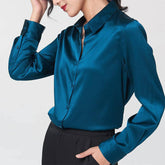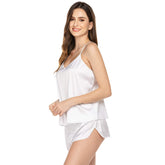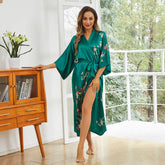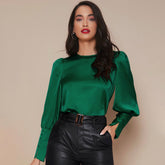What is Silk? | Its Uses, Types and Benefits
Silk is a natural protein fiber produced by insects, mainly silkworms (but sometimes others!) Renowned for its soft texture, lustrous appearance, and luxurious feel, silk has been treasured for centuries.
Discovered in 2696 BC by Chinese Empress Si Ling Chi, the history of silk is the stuff of legend! As the story goes, a cocoon fell into the Empress’s tea. A strand began to unveil as she watched it soften in the hot water. The Empress pulled the strand out of her cup and took it to her seamstresses to weave into fabric.
In ancient China, silk quickly became a symbol of status and wealth. By the time the Han dynasty came around, silk had evolved into an important economic asset, helping to establish the Silk Road trade routes. Discover the ins and outs of this luxurious fabric with the experts at Slipintosoft!
Types of Silk
There are several types of silk, each with unique characteristics and uses. Here’s an overview of the main types of silk and their distinct features.
Mulberry Silk
Mulberry silk is the most common type of silk, accounting for about 90% of the world’s silk production. It’s produced by the domesticated silkworm Bombyx mori. This silk has a naturally fine quality, smooth texture, and lustrous appearance.
Mulberry silk is hypoallergenic and contains natural proteins and amino acids that are beneficial for skin and hair. It’s often used in high-end garments, bedding, and various luxurious textiles due to its softness and durability. See our Mulberry silk pajamas
Tussar Silk
Tussar silk, also known as Kosa or Tussah silk, is made from the cocoons of the wild Antheraea mylitta moths and is known for its rich texture and natural golden hue.
It’s less durable than Mulberry silk, but is valued for its breathable nature and comfort, making it ideal for warm and humid climates. This wild silk is typically used in traditional Indian garments like sarees and is appreciated for its eco-friendly production process, as the silkworms are allowed to complete their life cycle.
Eri Silk
Eri silk, also called endi or erandi silk, is produced by the Samia ricini moth. This silk is distinct for its wool-like texture and excellent thermal properties, making it suitable for blending with other materials.
It’s often used in winter garments, such as shawls and blankets, and is known for its softness and comfort. Eri silk is a sustainable and eco-friendly silk, as the production process does not harm the silkworms.
Muga Silk
Muga silk is renowned for its natural golden color and is produced in Assam, India. This silk is made from the Antheraea assamensis silkworms, which feed on the leaves of the soalu plant.
Muga silk is highly prized for its glossy texture and durability, often used in traditional Assamese attire and high-quality garments. The unique climatic conditions and traditional craftsmanship in Assam contribute to the exceptional quality of Muga silk.
Other Types of Silk
Spider Silk
Spider silk is not produced by silkworms but by spiders, particularly the Madagascan species Nephila madagascarensis. This type of silk is incredibly durable and is used in specialized applications like bulletproof vests and optical instruments. Due to the difficulty in harvesting, spider silk is not commonly used in the textile industry.
Sea Silk
Sea silk, or mussel silk, is a rare and ancient type of silk produced by bivalve mussels found in the Mediterranean. This silk is known for its fine, golden threads and has been used since Ancient Greece. Sea silk is extremely valuable and is primarily found in Italy, particularly around the shores of Taranto, Italy.
Types of Silk Fabric


Aside from the types of natural silk, you also get various types of fabrics spun from silk fibers. Understanding these differences can help you choose the right silk for your needs.
Silk Satin
Silk satin is known for its glossy surface and dull back. It has a smooth finish, making it perfect for elegant evening wear, lingerie, and bridal gowns. This type of silk drapes beautifully and has a high sheen, adding a touch of glamour to any outfit.
Silk Chiffon
Silk chiffon is a lightweight, sheer fabric with a slightly rough feel. It’s often used for scarves, blouses, and flowing dresses. The delicate and airy nature of chiffon makes it perfect for creating layers and adding volume without weight.
Silk Crepe
Silk crepe features a crinkled texture with a dull luster. This fabric is versatile and used in both casual and formal wear. Its unique texture adds depth and interest to garments, and it’s regularly preferred for blouses, skirts, and dresses.
Silk Dupioni
Silk dupioni is a crisp fabric woven from double cocoon fibers, giving it a slightly irregular texture and a slight sheen. It’s highly favored for formal wear, including dresses and suits, due to its structured form and subtle shine.
Silk Brocade
Silk brocade is a shuttle-woven fabric known for its raised designs and figures. This luxurious fabric is often used for evening wear, upholstery, and decorative items. Its intricate patterns and rich texture make it a popular choice for special occasions.
Uses of Silk Materials
Not only is silk used in the textile and fashion industries, but it’s also used for home furnishings, medical, and industrial applications. Silk is much more versatile than you might imagine! Here are some details on the most popular uses of these fibers.
Textile and Fashion Industry
Silk is highly valued in the textile and fashion industry for its luxurious feel and elegant appearance. This fabric is commonly used to create high-end dresses, blouses, scarves, ties, lingerie, and various other types of clothing. Silk is a symbol of luxury, elegance, and status, often seen in designer collections and exclusive fashion lines.
Silk is frequently blended with other fibers to produce more affordable garments while retaining some of its desirable qualities. This blending helps make silk products accessible to a broader audience without compromising too much on the fabric’s natural beauty and comfort.
Home Furnishings
In home furnishings, silk is prized for its smooth texture and lustrous finish, adding a touch of sophistication to interiors. Silk bedding, including sheets, pillowcases, and duvet covers, provides a soft and comfortable sleep experience.
Silk is also a popular choice for curtains and drapes because of its elegant structure and ability to boost the aesthetic appeal of a room. It’s also used in upholstery for furniture, adding a luxurious touch to sofas, chairs, and cushions.
Its natural sheen and vibrant colors make it a preferred material for creating stylish and high-quality home decor items. Browse Slipintosoft’s silky collection to find something for your home!
Medical and Industrial Applications
In medicine, silk is used in surgical sutures because of its strength, flexibility, and biocompatibility, with minimal tissue reaction and faster healing. It’s also used in the production of prosthetic arteries.
Beyond medical uses, silk is used in the manufacturing of parachutes, valued for its lightweight strength and reliability. These applications highlight the versatility and importance of silk beyond its traditional roles in fashion and home decor.
Benefits of Silk


Silk is not only beautiful but also functional, with many advantages that synthetic fibers just can’t match. Here’s why you should choose to use or wear silk.
Health and Comfort Benefits
Silk is well-known for its hypoallergenic properties – it’s perfect for people with allergies or sensitive skin. The natural protein structure of silk resists dust mites, mold, and fungi, which can trigger allergic reactions.
Another huge benefit of silk is temperature regulation. It keeps you warm in winter by insulating heat, and cool in summer by allowing your skin to breathe. This makes silk garments and bedding the ideal choice for maintaining comfort throughout the year.
Environmental Advantages
Silk is an environmentally friendly material as it’s biodegradable. Unlike synthetic fibers that can take hundreds of years to decompose, silk is a natural fiber that breaks down without releasing harmful substances into the environment.
The production of silk also has a lower environmental impact compared to many other textiles, as it needs less energy and water. This makes silk a sustainable choice for eco-conscious consumers.
Longevity and Durability
Silk is a durable fabric that can last for many years when properly cared for. Its strong, natural fibers can withstand wear and tear better than many synthetic materials. Proper care can help maintain its quality and extend its lifespan. Investing in silk products means enjoying their benefits for a long time, making it a cost-effective option over time.
Silk Production Processs

Silk production is an ancient craft that dates back thousands of years. The process begins with the cultivation of silkworms, which produce the silk fibers used to make this exquisite fabric. Here’s an overview of the process.
Sericulture: The Cultivation of Silkworms
Sericulture is the practice of raising silkworms to produce silk. The primary species used is the Bombyx mori, whose larvae feed exclusively on mulberry leaves. The process begins with hatching silkworm eggs, followed by several stages of growth and molting.
Silkworms are carefully tended to ensure they have a consistent supply of fresh mulberry leaves, which is important for their development and the quality of the silk they produce.
Harvesting and Processing Silk
After the final molt, silkworms spin protective cocoons made of raw silk fiber. These cocoons are harvested before the silkworms can transform into moths. The cocoons are then boiled to soften the sericin, a protein that binds the silk threads together.
Once softened, the silk fibers are carefully unwound from the cocoon. Several fibers are combined to create a single thread, which is then twisted, dyed, and woven into fabric. This labor-intensive process results in the high-quality silk used in various textile products.
Modern Silk Production Techniques
Modern advancements in silk production have made a big difference in both efficiency and quality. One of the most useful modern innovations is automated reeling machines that precisely unwind silk from cocoons, reducing waste and increasing yield.
Genetic research has led to the development of silkworms that produce stronger and more lustrous fibers. Plus, sustainable practices are being implemented to reduce the environmental impact of sericulture.
Properties of Silk
Silk is prized for its beauty, comfort, and durability, making it a popular choice for luxury garments and high-end textiles. It’s also renowned for its unique combination of physical and chemical properties.
Physical Characteristics
Silk is luxuriously soft, smooth, and extremely comfortable against the skin. The fabric’s natural sheen comes from the prism-like structure of the fibers, which reflect light, giving it a lustrous appearance. Despite its delicate feel, silk is one of the strongest natural fibers available, providing remarkable strength and durability while remaining lightweight.
Chemical Properties
Silk is composed mostly of protein fibers, specifically fibroin. These protein fibers give silk its resilience and flexibility. It’s also resistant to most mineral acids, making it less susceptible to damage from acidic substances. However, silk is sensitive to harsh chemicals, like bleach. Overall, silk’s chemical composition allows it to maintain its integrity over time, even with regular use and exposure to various environmental factors.
Hypoallergenic Nature
One of the unique attributes of silk fibers is their hypoallergenic properties. Silk is naturally resistant to dust mites, mold, and other common allergens, making it an excellent choice for those with sensitive skin or allergies. This resistance helps to create a healthier and more comfortable environment, whether in clothing, bedding, or other textiles.
How to Care for Silk?
Silk needs special care to maintain its beauty and longevity. Proper handling and cleaning techniques will preserve its natural sheen and texture. Always follow the care instructions on the garment’s label to ensure the best results.
Regular Care for Silk Garments
Hand-wash silk items in lukewarm water using mild detergents specifically designed for delicate fabrics. Alternatively, you can opt for professional dry cleaning services. Do not use harsh chemicals, as they can damage delicate fibers. Gently squeeze out excess water without wringing the fabric and lay it flat to dry.
Handling Stains on Silk Fabric
Silk needs immediate attention when stained to prevent permanent damage. Blot the stain gently with a clean, dry cloth to absorb as much liquid as possible. Use a mild, silk-friendly stain remover and test it on a small, inconspicuous area first. Dab the stained area with the solution and avoid rubbing, which can spread the stain and damage the fibers. Rinse thoroughly with cool water and let the fabric air dry.
Long-Term Maintenance of Silk Textiles
To maintain silk textiles over the long term, always air dry or iron them on a low heat setting. Avoid exposing silk to high temperatures, which can weaken the fibers. When storing silk items, place them in a cool, dry place away from direct sunlight to prevent fading and deterioration. Use breathable fabric bags or wrap the garments in acid-free tissue paper to protect them from dust and pests.
FAQs on Silk?
What are some Alternatives to Traditional Silk?
There are several alternatives to traditional silk that cater to those looking for ethical and sustainable options. Ahimsa silk, also known as peace silk, is one such alternative. Although not extensively produced yet, this type of silk allows the moths to emerge from their cocoons before the silk is harvested, preventing the killing of the larvae.
Another option is organic silk, which is produced using fewer chemicals and more sustainable farming practices, making it a more environmentally friendly choice. These alternatives not only address ethical concerns but also reduce the environmental impact associated with conventional silk production.
Is Silk Eco-Friendly?
Traditional silk production raises environmental and ethical concerns. The conventional method in the silk industry involves boiling silkworm cocoons, which kills the larvae inside. This process, along with the extensive use of chemicals in silk farming and production, can harm the environment by contaminating water sources and soil.
While silk is a natural fiber and biodegradable, the methods used to produce it traditionally are far from eco-friendly. Choosing alternatives like Ahimsa silk or organic silk can promote a more sustainable approach to silk production.
Back to Top: What is Silk? | Understanding Silk Material and Its Uses










